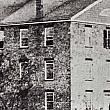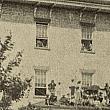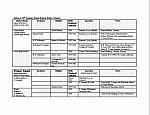
Ward Schools to the Rescue
by Diana Barrett
The Stone School, housing pupils of all ages, had become so crowded by 1855 that drastic measures were needed. Removing the youngest children from the Union School seemed the most practical method. The District members, voting at a school meeting on December 3rd, approved a plan to build three Ward Schools for primary schoolchildren. By the end of December the tax for their construction had been assessed.[1]
Ward schools, today’s primary or elementary schools, first appeared in Michigan during the 1850s. As a community’s population grew, ward schools helped relieve overcrowding in the union schools. Located within a neighborhood, or ward, they offered a shorter, safer walk for young children, an excellent selling point for new residents. The early buildings were usually small, two-room schools of wooden construction. By the late 19th century ward schools had, by name, morphed into primary schools. In response to rapid population growth, eight to twelve classrooms became the norm in neighborhood schools.
Records are scarce in the early Board history, and little has been written about these original ward schools. The three schools each cost $500 to construct, and measured 24 by 38 ft. Wood-burning stoves heated the classrooms and open windows cooled them; privies stood at the back of each lot.
The city built four ward schools between 1856 and 1860, numbering them according to the ward they served: Ward No. 1 on South Division; No. 2 on North Division; No. 3 on Fountain; and No. 4 on Wealthy. We are allowed only a glimpse of ward school architecture; as only a photograph of Ward School No.1 on South Division exists, but taken after basement classrooms were added in 1865.
‘Ward’ was eventually dropped from school names and ‘Primary’ adopted. Schools were numbered in sequence according to their construction date (except the two West Side primary schools). For example, Ward School No. 2, became Primary School No. 1, having been the first built. The final primary school to be named in this fashion was No. 12, on Coit Ave. New names, indicating their street location, were given to all primary schools in 1883. For the sake of clarity all primary schools will hereafter be referred to by their street names.
South Division Street School was built in 1856 on land rented in the Ellsworth Addition prior to the sale of lots to the public; the Addition was newly platted and mapped by Wright L. Coffinberry, a local surveyor. These rented lots were eventually purchased from the Ellsworth heirs in June of 1861.[2] The neat frame building, painted white, stood on the west side of Division Avenue near the tollbooth on the Plank Road, at the corner of Bartlett. It opened for the fall term of 1856 under the supervision of Principal William L. Gillman, one of the few males to oversee or teach children in the city’s primary schools before World War II. The two staff members were young women, probably still in their teens, Miss Malle Kingsbury, daughter of Solomon Kingsbury, and Miss Susan Prescott.[3] Female staff members changed frequently as these young ladies married and were replaced by other unmarried teen-agers who followed in their footsteps.
North Division Street School, at the SW corner of N. Division and E. Bridge Street, (now Michigan), was also constructed 1856 on leased land eventually purchased by the Board in 1865 for $1100. $5840 was set-aside in the treasury for a new brick building to be erected the following year with room for 300 students.[4] Miss Tryphena Farnham, Miss Lottie McKenzie, and Miss Annette E. Whitmore were early members of the staff.[5] Overcrowding at the school in 1865 forced the opening of a branch school in the basement of the German Lutheran Church of Immanuel, a neighbor on the corner across Division St,[6] just the first of dozens of rooms and buildings school boards would rent to supplement the shortage of classroom space.
Fountain Street School, built in 1858 on property purchased from the Coit family,[7] stood directly east of the Eggleston residence at the NE corner of Fountain St. and Prospect Ave., and just west of the present Central High School. In 1868, as a “temporary relief and to obviate the necessity for the large expenditure incident to the erection of a new ward schoolhouse, the Board has built an addition to [Fountain St. School].” The addition could seat sixty pupils. At the same time, the original building was repaired and newly plastered, new desks were added, and the school board determined it could be used for five more years. “In some of the schools it became necessary to divide the classes, allowing but a half day to each, and in others it was not unusual to find three and sometimes four scholars in places designed for two. This of course could not be endured.” [8]
Wealthy Avenue School, constructed in 1860 to accommodate the growing population at the southern boundaries of the city, was located at the NW corner of Wealthy and Prospect on property purchased for $305.25. Larger than the three earlier ward schools, it measured 36 by 64 ft., could seat 250 students, and cost $734.25.[9] The last of the four schools built for primary students to reduce congestion at the Union School, it barely relieved the overcrowding when it finally opened. In 1887 this wooden building was refitted and put back in service to handle the overflow of its replacement, which had been built at the corner of Lafayette in 1869.[10]
[1] Enquirer, Dec. 10, 1855, p3
[2] Note: Later, Ward School No. 1 became Primary School No. 2 and finally South Division Street School. Even the newspapers of the day sometimes confused the numbers and locations of the ward schools.
[3] Daily Enquirer, 9/17/1856, p 3; Daily Eagle, 10/18/1856, p 3
[4] Daily Eagle, 9/5/1865
[5] Daily Eagle, 1/28/1857, p 3
[6] GR Eagle, 3/31/1865
[7] Daily Enquirer, Dec. 5, 1855
[8] School Board of Trustees Minutes. GR Eagle, 9/8/1868
[9] Daily Enquirer, 10/5/1860
[10] Bd. of Ed. Minutes, 10/1/1887, p 35

 facebook
facebook














